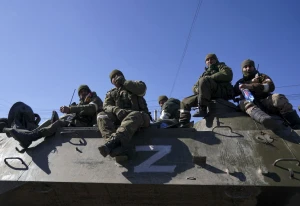
June 19-26 live war map: fighting intensifies, Russian forces break through near Toretsk
Over the past week, there has been a 30% increase in combat clashes. The Russian forces have intensified their activities significantly in certain areas: notably advancing in the Pokrovsk-Toretsk sector and increasing their presence in the Kupyansk area. However, their activity has decreased by nearly half in Zaporizhzhia and the southern Donetsk region
Vovchansk frontline
In the town of Vovchansk, fierce localized street fighting continues with no significant gains for either side. Due to substantial infantry losses, Russian forces appear to have recognized the stalling of their offensive. Consequently, they have shifted tactics, employing airstrikes with guided aerial bombs, including the formidable KAB 3000 — the most powerful bomb of its kind used by Russia in this war. These strikes targeted Ukrainian positions, particularly in Lyptsi, where Ukrainian forces have begun pushing back Russian advances. Additionally, the Russian troops have deployed thermobaric TOS-1 rocket artillery to devastate once densely populated urban areas.

Offensive on Kupyansk
In response, Ukrainian Defense Forces have launched systematic strikes deep into Russian territory. For instance, Ukrainian airstrikes successfully targeted and destroyed the command center of a Russian regiment located in the village of Nekhoteevka, Belgorod region. Additionally, Ukrainian drones carried out precision strikes on a field depot in the Olkhovatsky district of the Voronezh region, causing extensive detonations over several hours.
Furthermore, Ukrainian forces used HIMARS for the first time in an attack on the Kursk region. This operation targeted an FSB building in the village of Sudzha.
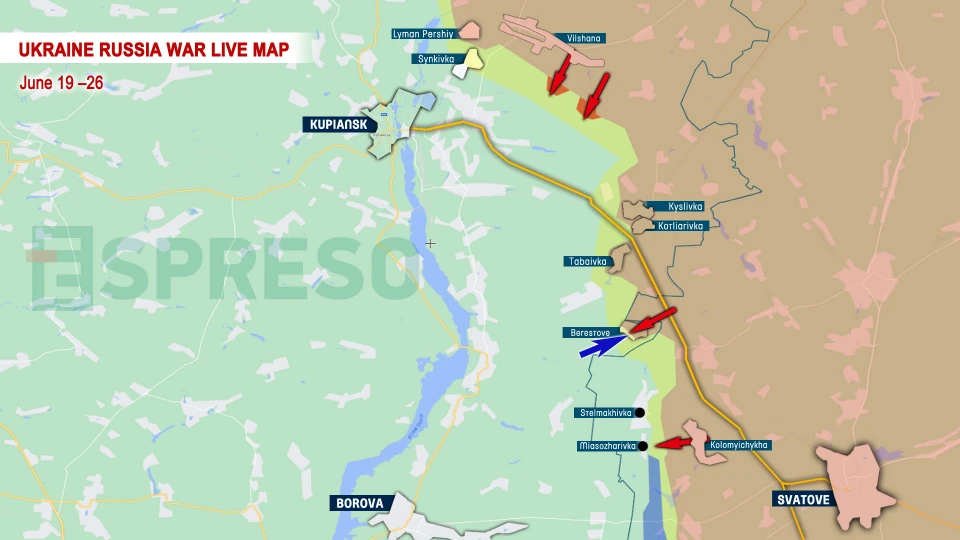
The publicized offensive on Borova has not yet begun, but there has been a significant escalation on the Kupyansk front, particularly on its northern flank. Here, occupying Russian forces have seized several of Ukrainian positions located between Vilshany and Synkivka. Additionally, Russian attacks were launched south of Berestove and west of Kolomyichyha, but the Defense Forces successfully repelled these assaults.
Ukrainian Armed Forces' failure in Toretsk
While the Defense Forces successfully held back the Russian forces near Chasiv Yar, preventing them from flanking the town or breaking through the Kanal area, the occupying army managed to seize Ukrainian positions near Toretsk almost without resistance. Due to uncoordinated actions during a rotation, the Armed Forces of Ukraine lost well-fortified positions on the outskirts of Toretsk, particularly in Shumy and Pivnichne, which had been fortified since 2014. In total, the Russian troops captured an area 2 km deep and 3.5 km long, coming close to the town's buildings.
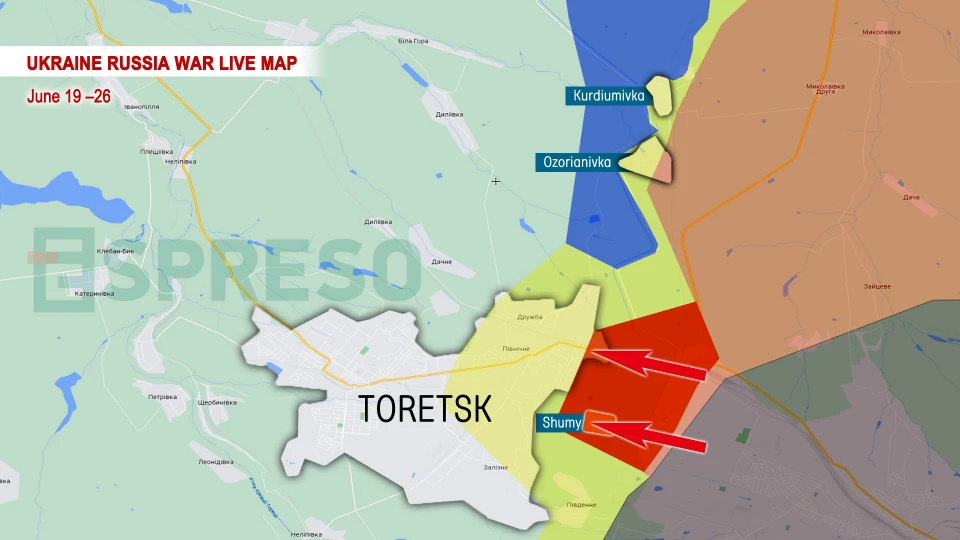 Although the Russian forces are likely not ready to storm Toretsk at this moment, they have improved their positions. This allowed them to increase pressure not only on Toretsk but also on the southern flank of the Chasiv Yar defense, near Kurdiumivka and Klishchiivka.
Although the Russian forces are likely not ready to storm Toretsk at this moment, they have improved their positions. This allowed them to increase pressure not only on Toretsk but also on the southern flank of the Chasiv Yar defense, near Kurdiumivka and Klishchiivka.
Pokrovsk front in anticipation of culmination
This week saw about 40 clashes near Toretsk, a similar number in the Vovchansk sector, and almost 300 in the Pokrovsk sector. The increasing number of clashes each week indicates that Russian forces, having tasted victory, are intensifying their efforts to capitalize on it.
During the week, the Russian forces continued advancing towards the Pokrovsk-Kostiantynivka road and nearly completed the occupation of Novooleksandrivka, advancing 500 meters. Additionally, the Russian army occupied half of Sokil village and attempted to bypass the settlement from the north towards Yevhenivka.

Near Novoselivka, the Defense Forces of Ukraine managed to hold off the invaders, preventing them from advancing from the previously occupied Novopokrovske. To the south, between Novopokrovske and Umanske, the Russian forces are gradually leveling the front and moving towards the southern outskirts of Novoselivka Persha. Despite being semi-encircled in Yasnobrodivka, Ukrainian troops managed to fully hold their positions throughout the week, as well as in the neighboring area near the Karlivka water reservoir.
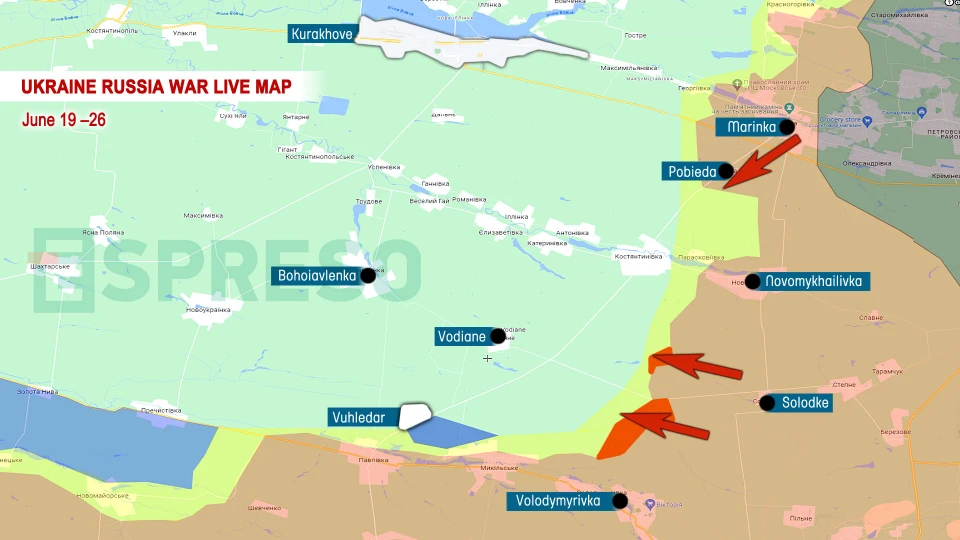
Surrounding Vuhledar
Although encirclement is still a long way off, the occupying Russian army has realized that it cannot take the town head-on, so it is gradually implementing a plan to cut off Vuhledar from its logistics. To achieve this, they need to block the road from Kurakhove, specifically in the area of Bohoyavlenka. Currently, the Russian forces need to advance another 13.5 kilometers to achieve this goal. Over the past year, they have advanced about 8 kilometers in this area of the front. In the past week alone, the Russian army managed to occupy a significant area near Volodymyrivka, advancing 4 kilometers to the west, which is a considerable blow to Ukrainian defense.
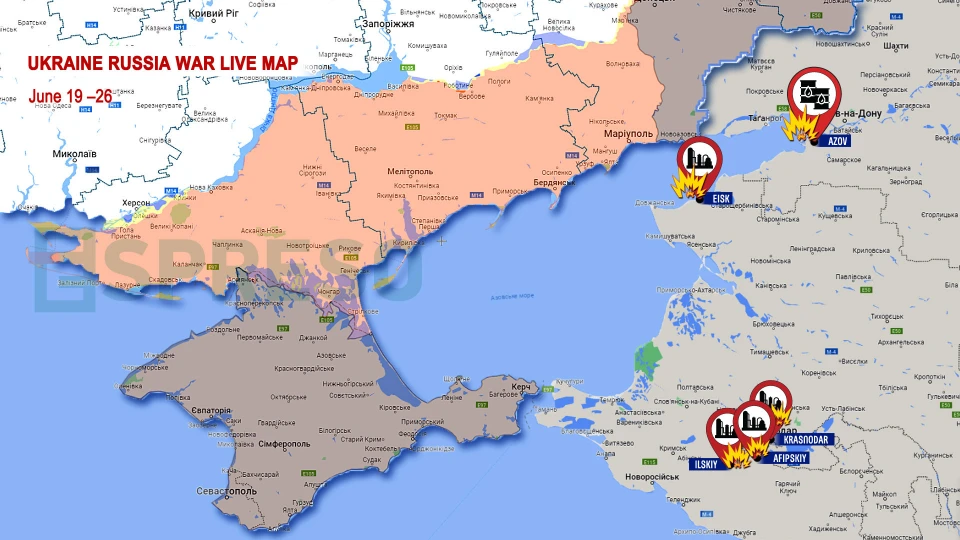
Destruction of Russian infrastructure on southern front
If we broadly examine the map, the situation in Crimea, Zaporizhzhia, and the southern Donetsk region heavily relies on the resources and logistics available in the southern regions of Russia.
Throughout the spring and into June, the Ukrainian Armed Forces have focused their attacks on these key regions. This week, in coordination with the Security Service of Ukraine, the Armed Forces attacked vital oil refineries in the southern district of Russia, including in Afipskiy, Ilskiy, and Krasnodar. Additionally, in Azov, Ukrainian drones destroyed half of a large oil depot. In Yeysk, they targeted and struck an air defense depot and a training center from where drones are launched across Ukraine. More than 120 drones of various types were destroyed.
The maps used to illustrate these operations are based on information from the General Staff of the Armed Forces of Ukraine and other open and verified sources. However, these maps are not perfectly accurate and only conditionally reflect trends in the combat zone.
- News









